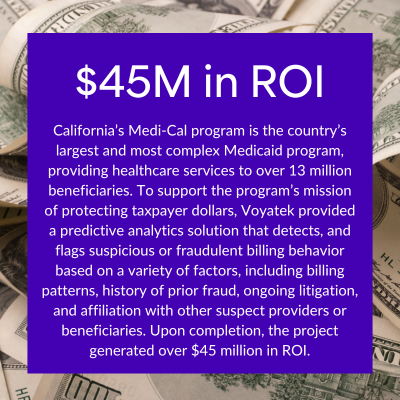Addressing Medicaid Fraud with Artificial Intelligence
Addressing Medicaid Fraud with Artificial Intelligence
Medicaid, a crucial program providing medical coverage to over 85 million poorlow-income and disabled Americans, spends approximately $734 billion annually. However, healthcare fraud has increasingly plagued this system, especially during the COVID-19 public health emergency. In 2021, improper Medicaid spending reached a staggering $98.72 billion, accounting for over 21% of total payments. Despite a slight decrease since then, fraud remains a significant issue.
Medicaid fraud is complex and often involves an array of internal and external actors, making it difficult to detect and mitigate. For example, fraud may be perpetuated by real Medicaid beneficiaries selling/sharing their ID information or healthcare providers billing for non-provided services. Bad actors can also exploit weaknesses in healthcare organizations like long-term care facilities or rehabilitation centers. Not to mention that state Medicaid agencies have limited time and resources to address the current scope of fraud, and the volume will continue to increase as bad actors leverage artificial intelligence (AI) to scale their efforts.
Fortunately, AI isn’tis not just a tool for criminals. Agencies can and should launch a multi-faceted strategy to fight Medicaid benefits fraud with AI and machine learning (ML) as the tip of the spear.
AI can analyze past instances of fraud and flag new filings that appear suspicious. For example, if multiple claims are associated with a single username, email address, bank account, or IP address, this could be identified and flagged using graph-based analysis. At the same time, ML-based pattern recognition is well-suited for uncovering fraud clusters. From these models, risk scores are created that prioritize cases for investigation, based on an agency’s unique business rules.

By incorporating AI into existing staff workflows, agencies can exponentially increase the scope, speed, and accuracy of existing fraud detection activities. Together, advanced analytics and AI can
- Integrate and analyze data from multiple sources, such as healthcare claims, pharmacy records, and financial transactions, to detect complex fraud schemes that may not be apparent when examining data in isolation.
- Analyze the behavior of both beneficiaries and providers to detect deviations from typical patterns. For example, if a provider suddenly starts billing for services that are not consistent with their usual practice, AI can flag this behavior as potentially fraudulent.
- More accurately verify identification documents. These systems can detect forgeries and alterations that may not be apparent to the naked eye.

However, when launching these AI-powered strategies, states must also consider the customer experience of the victims of fraud and avoid deploying a solution that is worse than the cure. If the process of interacting with an agency to resolve a fraud incident is difficult or time consuming, the user will become frustrated, damaging their trust in the agency. Plus, a lengthy resolution process is counterproductive for the agency. As long as the situation is unresolved, the agency can’t use lessons learned for future decision making or further integration into prevention and detection processes.
Fortunately, AI/ML can also be used to continuously monitor and analyze friction experienced by subsequently confirmed users to improve future interactions with government systems and processes not only for that specific user, but others with similar circumstances.
For example, AI chatbots, driven by improvements in natural language processing, can streamline the resolution workflow and reduce customer friction, while also freeing up humans to handle issues that demand greater emotional intelligence. Ideally, agencies should let customers set their level and type of engagement to enable a positive customer experience.
While these AI strategies require some up-front investment, the return on that investment results in increased staff productivity and speedier responses to fraudulent activities.
-Rich Corey, SI/Consulting Service Line Lead, Voyatek

